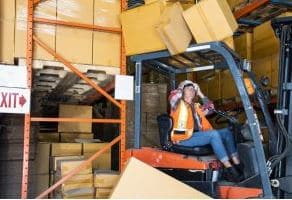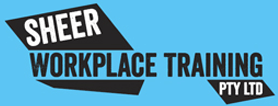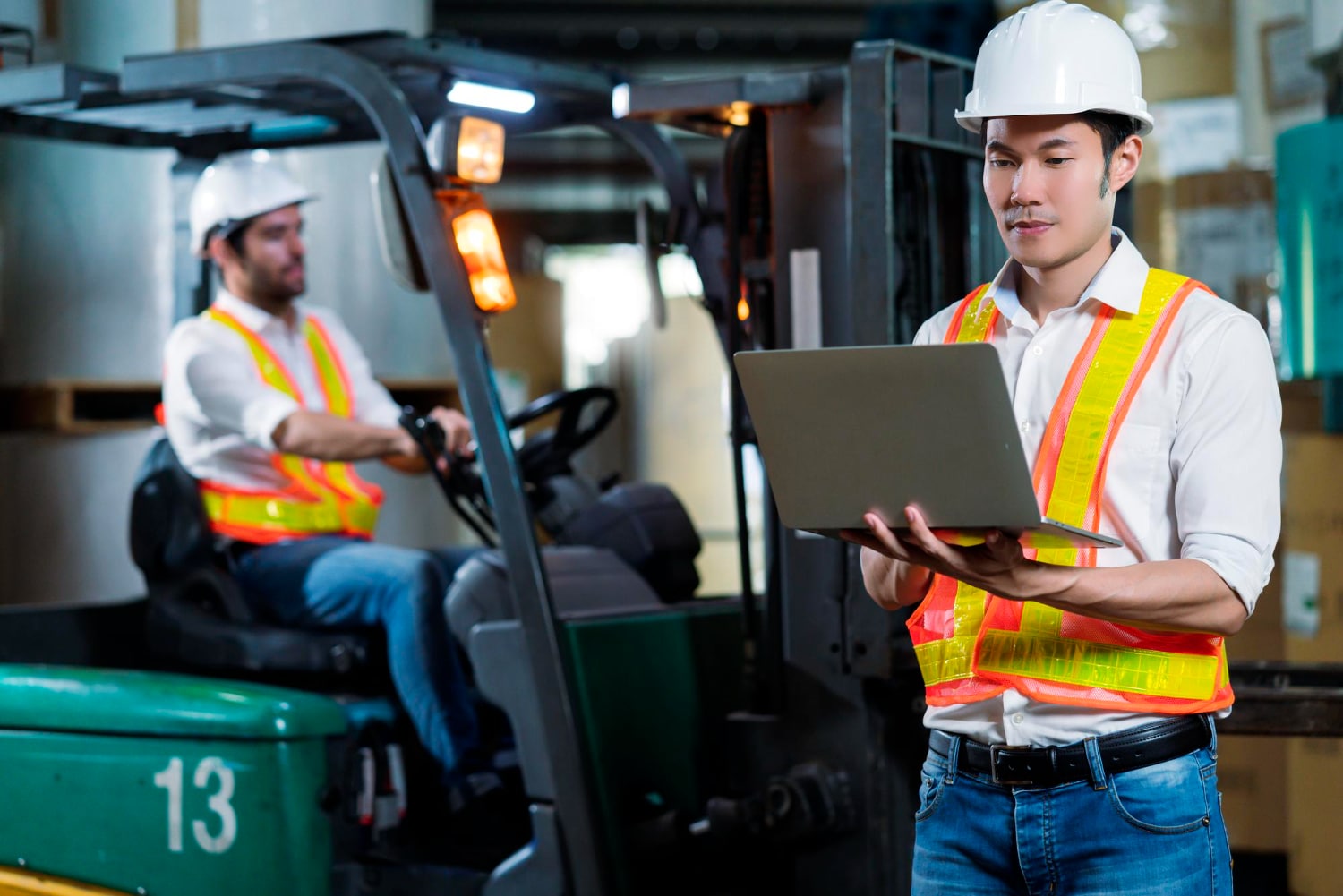The Essentials of Forklift Operation
Forklifts play a crucial role in material handling across numerous industries, making them indispensable. Dive into the world of forklifts with us, from internal combustion engines to electric models, and discover how each type is tailored for specific tasks. This knowledge is not just a requirement; it’s your first step towards mastering safe forklift operations, ensuring you’re not just another operator, but a skilled professional ready to tackle any challenge in the warehouse or on the construction site.
Mastering Forklift Safety for Optimal Workplace Protection
Safety is paramount in forklift operations.
- Understanding Forklift Mechanics and Controls
- Learn the mechanics and controls of both internal combustion engine and electric forklifts.
- Familiarize with different forklift models and their specific operational features.
- Adhering to Load Handling Protocols
- Follow proper techniques for assessing, lifting, and transporting various types of loads.
- Understand load capacity and balance to prevent forklift tipping or load drops.
- Implementing Speed and Operational Safety Measures
- Observe set speed limits and follow operational safety guidelines during forklift maneuvers.
- Practice safe turning, reversing, and stopping techniques.
- Utilizing Personal Protective Equipment (PPE)
- Wear appropriate PPE such as hard hats, safety shoes, and high-visibility vests.
- Ensure PPE is in good condition and used consistently.
- Recognizing and Addressing Hazards
- Identify potential hazards like slippery surfaces, uneven loads, and obstructed pathways.
- Take immediate action to mitigate recognized hazards.
- Maintaining Clear Communication
- Use signals, horns, and maintain a safe distance from workers and obstacles.
- Ensure clear and effective communication in operation areas.
- Emergency Response Preparedness
- Be trained in emergency procedures for forklift malfunctions or accidents.
- Know the steps for quick and efficient emergency response.
Forklift operators must be vigilant to maintain a safe and efficient working environment. Proper training is necessary to handle loads securely and navigate through diverse workplace settings.
Navigating the Forklift License Process: A Comprehensive Guide
Obtaining a forklift license is a significant step towards becoming a proficient operator.
- Understanding Licensing Requirements: Research and understand local forklift licensing requirements and regulations.
- Choosing the Right Training Program: Select a comprehensive training program covering theoretical and practical elements of forklift operation.
- Completing Theoretical and Practical Training: Engage in both classroom-based theoretical learning and hands-on practical training.
- Passing the Assessment: Successfully complete the assessment process, including written tests and practical demonstrations.
- Continuous Learning and Re-certification: Engage in ongoing training and re-certify as required to stay current with safety standards and regulations.
In Brisbane, Sheer Workplace Training offers comprehensive courses that cover every aspect of forklift operation. The process involves theoretical knowledge and practical skills, ensuring that every trainee is well-equipped to operate a forklift safely.
Forklift Operator Responsibilities: Ensuring Workplace Efficiency and Safety
A forklift operator’s responsibilities extend beyond just driving the vehicle. They include efficient and safe handling of materials, ensuring the forklift is operated manually within the set parameters, and contributing to the overall productivity of the workplace.
- Operating Forklifts According to Established Protocols: Follow established routes, speed limits, and operational guidelines for forklift usage.
- Regular Inspection and Maintenance Checks: Conduct routine inspections and maintenance, especially for internal combustion engines or electric forklift batteries.
- Efficient Material Handling: Plan and execute material movement strategies to optimize workflow and safety.
- Ensuring Safety in Diverse Operating Environments: Adapt operating techniques to suit different environments, like warehouses or construction sites.
- Reporting and Documenting Incidents: Report safety incidents and forklift malfunctions responsibly and maintain accurate documentation.
- Promoting a Culture of Safety: Mentor new employees and advocate for a strong safety culture within the workplace.
- Continuous Skill Enhancement: Regularly engage in training and skill development to stay updated with best practices in forklift operation.
Maintaining and Inspecting Forklifts for Optimal Performance and Safety
- Regular Check of Forklift Fluids and Fuel Systems
- Ensure fuel levels are adequate and check for leaks in internal combustion engines.
- Regularly inspect and maintain hydraulic fluids and coolants in electric forklifts.
- Inspecting Forklift Tires and Brakes
- Check tire pressure and tread for signs of wear and tear.
- Regularly inspect brake performance to ensure safe stopping capabilities.
- Ensuring Proper Battery Maintenance for Electric Forklifts
- Regularly clean and inspect batteries, checking for corrosion and proper charge levels.
- Follow manufacturer guidelines for charging and handling batteries.
- Checking Forklift Forks and Mast Operation
- Inspect forks for damage, distortion, or cracks.
- Test mast operations for smooth lifting and lowering of loads.
- Monitoring and Maintaining Control Systems
- Regularly check the forklift’s steering, lifting, and tilting controls for responsiveness and accuracy.
- Address any control issues immediately to prevent operational hazards.
- Verifying Safety Features and Alarms
- Test safety features like seat belts, lights, and reversing alarms.
- Ensure all safety equipment is functioning correctly and is easily accessible.
- Maintaining a Clean and Clear Operator View
- Keep the operator’s view clear of obstructions, both internally and externally.
- Clean mirrors, windows, and any visual aids regularly.
A well-maintained forklift is crucial for safe operations and longevity of the equipment.
Preventing Forklift Accidents: Understanding Common Hazards and Mitigation Strategies
Forklift accidents can be mitigated by understanding common hazards such as improper load handling or ignoring speed limits.
- Awareness of Surroundings and Pedestrian Traffic
Stay vigilant about the surrounding environment, especially in areas with high pedestrian traffic.
Use mirrors and cameras to enhance visibility and avoid blind spots.
- Load Stability and Securement
Ensure loads are stable and securely placed before moving.
Avoid overloading and uneven distribution, which can lead to tipping accidents.
- Navigating Tight Spaces and Aisles Safely

Practice caution in narrow aisles and tight spaces to avoid collisions and accidents.
Adjust speed and handling according to the space constraints.
- Proper Training on Forklift Maneuvering
Ensure operators are properly trained in forklift maneuvering techniques.
Conduct regular refresher courses to maintain high skill levels.
- Implementing a Forklift Traffic Management Plan
Develop and enforce a forklift traffic management plan in the workplace.
Designate specific routes and areas for forklift operation to minimize risks.
- Regular Safety Drills and Training Sessions
Conduct regular safety drills and training sessions to prepare operators for emergency situations.
Emphasize the importance of quick and appropriate responses to potential hazards.
- Establishing a Reporting System for Safety Concerns
Implement a system for reporting safety concerns and potential hazards.
Encourage a culture of safety where operators feel comfortable reporting issues.
At Sheer Workplace Training, we emphasize on practical training sessions that simulate real-world scenarios, thereby preparing our trainees to anticipate and manage such hazards efficiently.
Elevating Your Career with a Forklift License from Sheer Workplace Training
A forklift license obtained from Sheer Workplace Training is not just a piece of paper; it symbolizes a deep commitment to maintaining safety and enhancing efficiency in the workplace. Located in the heart of Brisbane, with facilities in Hemmant and Paget, our training center is dedicated to transforming individuals into skilled, responsible, and safety-conscious forklift operators.
At Sheer Workplace Training, we understand that operating a forklift safely involves more than just driving. It’s about understanding the intricacies of different types of forklifts, including those with internal combustion engines and electric forklifts, and mastering the art of material handling. Our comprehensive training courses are designed to provide hands-on experience, ensuring that our trainees not only learn how to operate forklifts safely but also understand their responsibilities in maintaining workplace safety and efficiency.
Our program covers essential topics such as:
- Proper Load Handling: Learning how to handle loads effectively and safely, minimizing the risk of accidents.
- Navigating Forklift Speed Limits: Understanding and adhering to speed limits to ensure safety in the workplace.
- Forklift Maintenance and Inspection: Regularly checking the condition of the forklift, including its engine or battery, to ensure optimal performance.
- Safety and Emergency Protocols: Being prepared for any situation with the knowledge of safety and emergency procedures.
By joining Sheer Workplace Training, you’re not just earning a forklift license; you’re gaining a valuable skill set that will serve you throughout your career. Our experienced instructors are committed to providing quality education and hands-on training, ensuring that every trainee leaves with the confidence and competence to operate forklifts safely and efficiently.
We invite you to embark on this rewarding journey into the world of forklift operation with us. Whether you’re looking to enhance your skills, advance your career, or ensure a safer working environment, our forklift training courses are designed to meet your needs. Share your thoughts, ask questions, or get in touch for more information on our forklift training courses at Sheer Workplace Training. Your pathway to becoming a skilled forklift operator starts here!



Leave a Reply